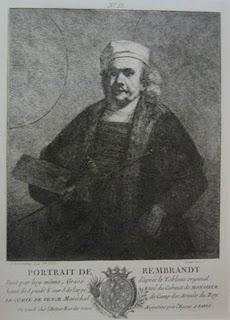 Rembrandt, Self-PortraitEtching by Antoine de Marcenay de Ghuy, 1755
Rembrandt, Self-PortraitEtching by Antoine de Marcenay de Ghuy, 1755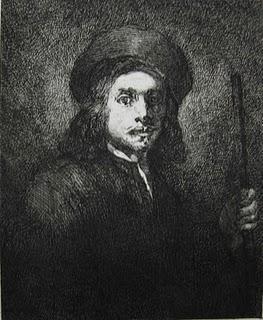 Rembrandt, Autoportrait (tenant un bâton dans la main gauche)Etching by Pauline Wissant, 1871
Rembrandt, Autoportrait (tenant un bâton dans la main gauche)Etching by Pauline Wissant, 1871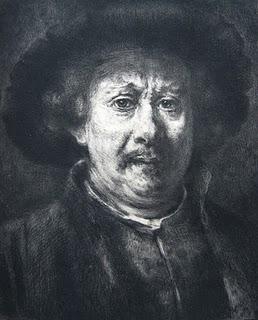 Rembrandt, Portrait de l'artisteEtching by Charles Waltner, 1906
Rembrandt, Portrait de l'artisteEtching by Charles Waltner, 1906Rembrandt Harmenszoon van Rijn (1606-1669) scarcely needs any more words added to his fame by me. But there are some interesting things to say about his etchings (and I'll just use the word etching to describe them, even though many also show touches of the drypoint needle and the engraver's burin). Rembrandt made about 300 etchings, issuing them in various states with sometimes very small modifications; he had already discovered the kind of collector-based marketing that enables music companies to sell us the same music over and over again by adding an extra track or a remix. The first Rembrandt etchings were pulled by Rembrandt himself, and even if not all the lifetime impressions were hand-printed by Rembrandt, it is obvious that a lifetime proof will be of far greater value than any posthumous one.
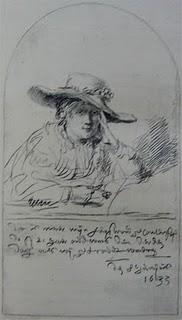 Rembrandt, Saskia van UlenburgEtching by William Unger, 1876
Rembrandt, Saskia van UlenburgEtching by William Unger, 1876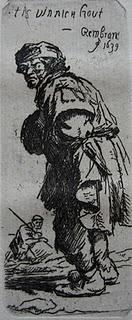 Rembrandt, Un GueuxEtching by Henri Guérard, 1876
Rembrandt, Un GueuxEtching by Henri Guérard, 1876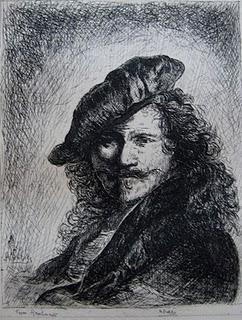 Rembrandt, Portrait de Rembrandt, d'après lui-mêmeEtching by A. Protche, 1974
Rembrandt, Portrait de Rembrandt, d'après lui-mêmeEtching by A. Protche, 1974With posthumous impressions, however, the water gets murkier. It's not necessarily so that the earliest posthumous prints from Rembrandt copper plates are the best, nor that what is printed is entirely Rembrandt's. Copper is a very soft metal, which is what makes it ideal for etching and drypoint, but this softness also means that copper plates wear away with alarming speed. At various times engravers, often highly skilled, have tried to "improve" degraded Rembrandt plates, taking the image ever further from the touch of Rembrandt's own hand. The mid-nineteenth century put a stop to that, with the invention of the process known as steel facing, whereby a copper plate is given a thin coating of steel by electrotyping. This steel face does not damage the plate, and can be removed from it. It prevents any further wear, though obviously it cannot repair wear already received, nor remove the traces of previous restorers.
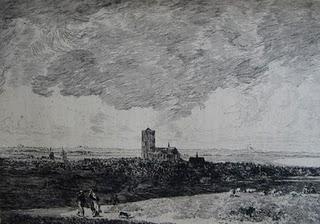 Rembrandt, PaysageEtching by Jules Jacquemart, 1877
Rembrandt, PaysageEtching by Jules Jacquemart, 1877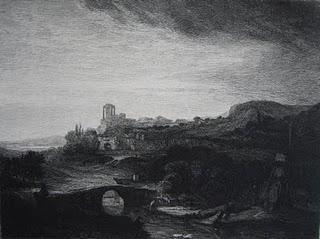 Rembrandt, Landschaft mit ruinenEtching by William Unger, 1886
Rembrandt, Landschaft mit ruinenEtching by William Unger, 1886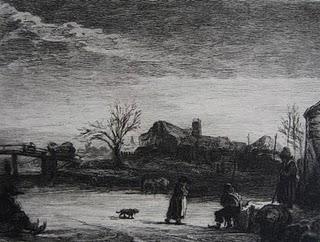 Rembrandt, WinterlandschaftEtching by William Unger, 1886
Rembrandt, WinterlandschaftEtching by William Unger, 1886A large collection of Rembrandt copper plates, deriving from the estate of Rembrandt's close friend, the Amsterdam print dealer Clément de Jonghe, has survived to this day. After passing through various hands, it was sold at auction in London in 1993, and the plates dispersed. Eight of these have since been reprinted, with some controversy you can easily discover for yourself via Google, as the Millennium Edition. I don't have any of these controversial Rembrandt re-strikes, but I do have two beautiful Rembrandt etchings printed from other plates in the same hoard in 1929. At that date the plates belonged to M. Alvin-Beaumont, who had bought them in 1906. He had the plates rigorously assessed and then vehemently championed by the etcher and art historian Charles Coppier, and the publication of small editions of three of them in 1929 was accompanied by a long and argumentative essay by Coppier, mainly concerned with rubbishing the expertise of every previous authority on Rembrandt's etchings. This extreme cross-fighting in the field of Rembrandt studies has continued unabated to the present day. The plates were published in an edition of 605 copies on very high-quality laid paper. There is a watermark (filigrane) in the paper, but unfortunately I don't recognize it. The publisher was the art revue Byblis: Miroir des arts du livre et de l'estampe. This was published in two editions: 105 deluxe copies, with the text on Arches, and 500 ordinary copies, with the text on vélin pur fil Lafuma. The deluxe copies had extra prints, many prints in two different states, and many prints hand-signed by the artists. As mine is one of the ordinary ones, it only has two Rembrandt prints, lacking Les Pélerins d'Emmaüs of 1654. The printer Jacquemin, Paris. Coppier writes of the plates and the proofs: "Ces trois cuivres, on le voit, sont à peu près intacts, et donnent encore des épreuves magnifiques." These three plates, as can be seen, are almost pristine, and still yield magnificent impressions.
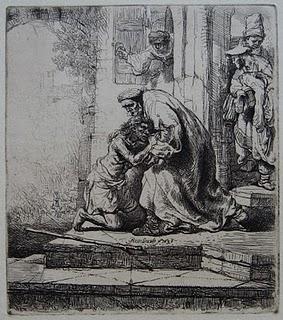 Rembrandt Harmenszoon van Rijn, The Return of the Prodigal SonOriginal etching, 1636Printed from the original copper plate in 1929Refs: Bartsch 91, Hind 147
Rembrandt Harmenszoon van Rijn, The Return of the Prodigal SonOriginal etching, 1636Printed from the original copper plate in 1929Refs: Bartsch 91, Hind 147The earlier of my Rembrandt etchings is Le retour de l'enfant prodigue (The Return of the Prodigal Son), etched in 1636. After the 1993 sale, the original copper plate for this was bought by the Rembrandthuis. The Biblical scene is rendered with great pathos and emotion. There's a good essay on this etching here, so I won't go on about it!
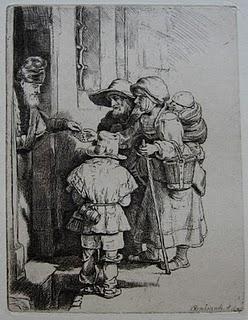 Rembrandt Harmenszoon van Rijn, Beggars Receiving Alms at the Door of a HouseOriginal etching, 1648Printed from the original copper plate in 1929Refs: Bartsch 176, Hind 233
Rembrandt Harmenszoon van Rijn, Beggars Receiving Alms at the Door of a HouseOriginal etching, 1648Printed from the original copper plate in 1929Refs: Bartsch 176, Hind 233My second Rembrandt etching is Les mendiants à la porte d'une maison (Beggars Receiving Alms at the Door of a House) from 1648. This is a very interesting scene in which Rembrandt explores his enduring fascinating with beggars and outcasts; perhaps he felt that at any moment he might become one. The website of the Rijksmuseum notes that the father of this beggar family is probably blind, and that he is carrying a hurdy-gurdy, "the typical instrument of the itinerant musician".
 Rembrandt, Portrait d'hommeEtching by Charles Courtry, 1881
Rembrandt, Portrait d'hommeEtching by Charles Courtry, 1881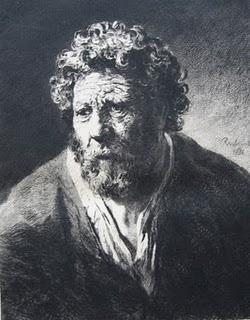 Rembrandt, Tête de vieillardEtching by Jules Jacquemart, 1877
Rembrandt, Tête de vieillardEtching by Jules Jacquemart, 1877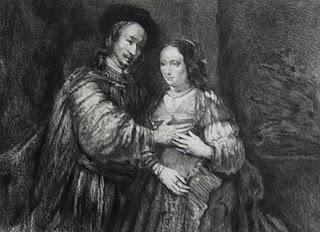 Rembrandt, Die Judenbraut (The Jewish Bride)Etching by Willem Steelink, 1891
Rembrandt, Die Judenbraut (The Jewish Bride)Etching by Willem Steelink, 1891Rembrandt's complete etchings can be explored here. One word of warning before I go. In the nineteenth century the firm of Amand-Durand made excellent heliogravure facsimiles of Rembrandt etchings. These are photo-engravings (possibly with some fine detailing by drypoint) rather than hand-made prints. So convincing are they that they are often offered for sale as original etchings after Rembrandt. Decorative and desirable they may be, but etchings they are not.
 Rembrandt, Portrait of His WifeEtching by N. S. Mossolow, 1892
Rembrandt, Portrait of His WifeEtching by N. S. Mossolow, 1892

